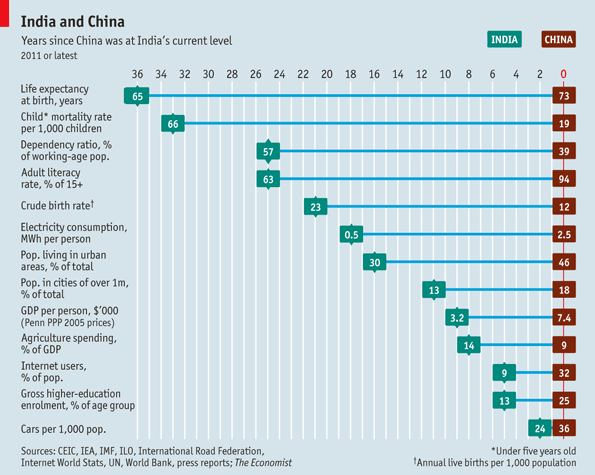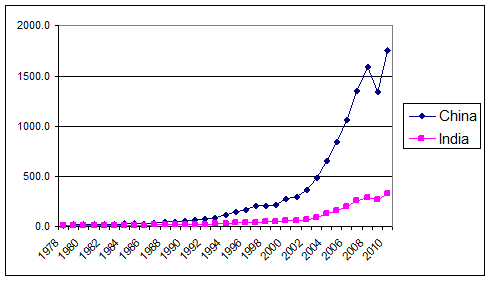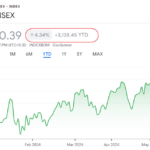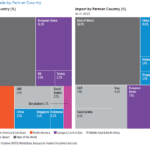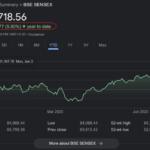China and India are two of the largest emerging markets in the world. With rising middle-class and increasing wages, the countries are experiencing tremendous economic growth. However in terms of overall growth, India still lags behind China in most metrics. This is despite India being the world’s largest democracy and China being a communist state with a one-party rule. Though both countries embraced free market capitalism, China’s political system keeps the country on the right track by focusing on economic prosperity and country’s development while India’s political system breeds chaos, corruption and other social ills that fails to lift the majority of the population. China’s huge manufacturing sector offers well-paying jobs for workers. India’s manufacturing base is low in comparison and the much-hyped IT sector employs a small fraction of the working population.
I came across two articles that discussed the differences in growth between India and China. From The Economist article Comparing India and China – Chasing the dragon:
The chart shows the number of years that have elapsed since China passed the development milestones that India has now reached. India’s income per head, for example, was about $3,200 in 2009 (holding purchasing power constant across time and between countries). China reached that level of development nine years ago. The lag in social progress is much longer. A child’s odds of surviving past their fifth birthday are as bad in India today as they were in China in the 1970s. Moreover, the chart does not necessarily imply that India in nine years’ time will be as rich as China is today. That is because China grew faster in the last nine years than India is likely to grow over the next nine. We stopped the clock at $3200 per head. But China did not stop racing ahead.
From Will India overtake China in the next decade? by Ganeshan Wignaraja in Vox:
China currently dominates world manufacturing export markets, while at the same time it is taking a larger global share of medium- and high-technology exports. In achieving its pre-eminent status, China benefited from favourable initial conditions including a large domestic market, low-cost productive labour, and the geographical advantage of its proximity to Japan, the previous engine of Asian growth. Even more importantly, China pursued a swift and coordinated economic liberalisation programme beginning in 1978 that served as a catalyst for subsequent decades of economic growth. This reform programme included:
An open-door policy toward foreign direct investment (FDI)
Promotion of technology transfer through FDI
Steady liberalisation of a controlled import regime
Export incentives, and
A strategic approach to free trade agreements (FTAs) with neighbouring Asian economies.By comparison, India’s economic liberalisation did not begin until 1991 – more than a decade later – and it focused more narrowly on easing restrictions on FDI and imports. In recent years India has accelerated reform of FDI entry regulations and import tariffs (Bardhan 2010). For instance, India’s simple average import tariffs reached 13% in 2009 compared with 10% for China. Nonetheless, as a result of China’s “first-mover” advantage and more comprehensive liberalisation programme, it has been able to achieve consistently higher trade growth than India for the past several decades and has a much larger export base than India.
From less than $10 billion in 1985, Chinese exports ballooned to $1.8 trllion in 2010, accounting for 11% of world exports (see Figure 1). Meanwhile, Indian exports, which were also less than $10 billion in 1985, have grown more modestly to $326 billion in 2010 and account for 2% of world exports. Over this same period, China’s share of world export manufactures jumped from 0.5% to 11%, while India’s share increased from 0.5% to around 2%.
The above articles clearly show that India’s economy has to accelerate faster to catch up with China. Democracy with free-market capitalism offer the best combination for emerging countries to develop into advanced countries. However the current democratic system is corrupt and needs a complete overhaul. China’s population seem to be content with the current market socialism system as it raising the standard of living for the majority. But in the long run the Chinese may demand full freedom and initiate a peaceful transition to democracy.
Related ETFs:
PowerShares India (PIN)
iShares S&P India Nifty 50 (INDY)
iShares FTSE/Xinhua China 25 Index Fund (FXI)
Disclosure: No Positions
